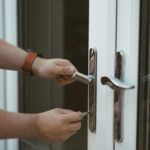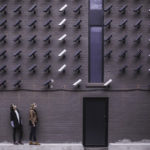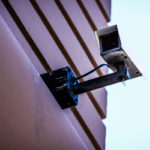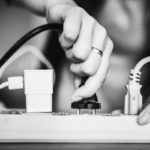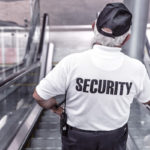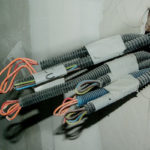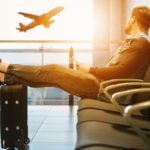Safeguard Your Property
Spring is almost here! With warmer weather on the horizon, many of us may have vacations or weekend getaways planned. Before you leave your house unattended, make sure you’re doing your best to keep your home secure. Here are some helpful home security tips to safeguard your home and property.
Maintain Landscape
Your landscape can be an asset or a weakness to your home security, depending on how you utilize it. To protect your property, you want to limit the potential hiding places that your shrubbery can provide. Consider planting thorny bushes under your windows and be sure to keep them trimmed. You may also want to install motion-activated lights along your landscape to further discourage intruders.
Deter Porch Pirates
While online shopping is convenient, it leaves you susceptible to porch pirates. If you’re having packages delivered to your doorstep, work with the delivery companies to improve security. You can request a text when a delivery is made, require a signature upon delivery, or ask for packages to be left in a less prominent location. Another way to deter package theft is to install security cameras at your front door and around your home to monitor activity.
Hide Valuables
You don’t want anyone passing by your street to be able to see all of your valuables. Instead, arrange your furnishings in a way that they are less visible from the street-side window. Also, keep your garage openers and car keys out of sight from any window. Store these in a cabinet or drawer to keep them hidden.
Reinforce Entry Points
You want to be sure that any point of entry, whether window or door, has the proper protection. Exterior doors should be metal or solid wood and at least 1 ¾ inches thick. Protect your windows with locks or burglar-resistant glass, and reinforce sliding doors with a metal bar. A security alarm can also be beneficial by alerting you when a door or window opens as well as alerting authorities when your system is breached.
Practice Safe Behaviors
Personal habits can play an important role in your home security. Make it a habit to lock your doors and windows and arm the security alarm system whenever you leave. If you’ll be gone for more than a few days or on an extended vacation, you should make it look as if your home is occupied. Leave blinds as they would be usually, plan to defer your mail and other deliveries, and use light timers and smart home devices in different areas of your home. Bonus tip: If you are leaving your keys with a parking attendant, remove your house keys – tech-savvy thieves can duplicate your house keys by simply taking a picture of it.
Share your own home security tips with us and your peers on Facebook, Twitter, LinkedIn, and Pinterest. Browse our wide selection of CCTV security cameras, video surveillance systems and more at SecurityCamExpert.com or call 888-203-6294 today!
Restaurant Security: Night Vision Cameras
Night vision cameras offer a bit more than standard security cameras. The ability to see in low light to near darkness enables surveillance around the clock. While you may understand how this can help you feel safer at home, many businesses can also take advantage of these benefits. Here are some of the ways night vision cameras can be a great asset for restaurants.
- Vision In Darkness
Aside from keeping an eye on the premises overnight, night vision cameras can do their duty during late night business hours. If customers are staying late, it can help make the closing staff feel safer. - Easy To Install & Use
Most night vision cameras are fairly straightforward with their design, some being plug-and-play, making them easy to install and use. - Central Monitoring
Depending on your system, you should have access to any camera feed at any location at all times. If your system permits, this may even be accessible remotely via your smart device or a laptop. - Transferrable Feed
Your recordings can immediately transferred to disk for long term storage. This backup allows you to review past video or share footage promptly should authorities require video evidence of an incident. - Prevent Theft
The simple presence of a security camera can deter burglars from acting. However, in a restaurant setting, these things can easily be overlooked. With surveillance cameras, you may be able to improve inventory control and prevent employee theft. - Prevent Over-Pouring
Along the same lines, if you have a bar in your restaurant, you can keep an eye on your bartenders. Over-pouring is way to lure customers to leave larger tips, but can leave you at a loss. If you come across this issue, you can refer to your footage and correct the problem. - Reduce Violence
Whether among customer, employees, or both, security cameras can help to reduce violence or provide helpful evidence when a problem arises.Night vision cameras can also make your employees feel safe, as mentioned. Employees are happier with employers who show that they care about their safety and well-being. - Boost Productivity
Security cameras in the workplace can alleviate management from the task of security as well as motivate employees and keep everyone on task.
For a wide selection of night vision cameras, surveillance system packages, and more, please visit SecurityCamExpert.com or call 888-203-6294. You can also connect with us on Facebook, Google+, Twitter, LinkedIn, and Pinterest.
Security Cameras: Do’s & Don’ts
Security cameras help to protect homes, businesses and various properties from burglaries, vandalism and more. Unfortunately, if they are not installed properly, they can do more harm than good. Before you invest and install a video surveillance system on your property, review these security camera do’s and don’ts.
DO:
- Place the camera where the roof or ceiling meets the wall.
This spot naturally shields the camera from the elements, and it can usually give you the widest angle of viewing. - Protect your cameras from weather, tampering, and vandalism.
Depending on your security cameras location, you may need to invest in a weatherproof casing to shield it from environmental conditions. Also, be sure to mount your cameras out of reach and with a protective plate to prevent criminals from tampering, disabling, or damaging your equipment. - Securely mount your surveillance cameras.
Be sure that your cameras don’t shake or wiggle if walking or other movement sends vibrations to the wall. This instability could distort the images that your camera is transmitting and could potentially cause damage to your cameras. You may need additional mounting brackets or equipment to ensure your cameras are securely mounted. - Place cameras in heavily-trafficked or shrub-heavy locations.
Because bushes provide cover for intruders, having a camera monitor these potential hiding spots will improve your surveillance. You also want to have eyes on areas with heavy traffic such as walkways or gates. - Set your base unit in your attic.
This is often the most convenient spot for all of your cameras’ wiring to originate from. It also minimizes the need to string cables up and down walls if they can be run on the insides of your eaves under your roofline.
DON’T:
- Just install a camera in an area that won’t be well-lit at night.
If you want surveillance around the clock, be sure that your security cameras have night vision or an infrared setting or lens that works in low light. For outdoor cameras, pair your cameras with exterior lighting with motions sensors if possible. - Attach a camera to a gutter.
This is always a bad idea. Despite being high up and out of reach, the camera is completely exposed to the weather and its weight will put undue stress on your guttering system. - Limit your cameras to just your front door.
You should be monitoring all areas where criminals can potentially gain access. Install surveillance cameras near your back doors, side entrances, and sliding glass entryways. You may want to consider a security camera at the top of your basement stairs in case someone gains access to your basement. - Place a camera right above a basement window.
This location leaves your camera within reach to be disabled or vandalized. Instead, mount a camera under the eaves or even a second-story roofline and direct the lens toward the basement window. - Assume wireless means “completely wireless.”
This is not always the case. Even if your surveillance system operates using wireless signals, each camera and your base unit will still need to be plugged into a power source.
Share your own tips with us and your peers on Facebook, Google+, Twitter, LinkedIn, and Pinterest.
Your security is our priority! If you need help choosing the best security cameras for you, feel free to browse our selection online at SecurityCamExpert.com or call 888-203-6294 to speak with a representative directly.
Mounting Outdoor Security Cameras
Outdoor security cameras aid in your first line of defense against criminals. The presence of outdoor security cameras can deter burglars from targeting you, or they can provide key evidence should an incident occur. Thus, the installation and mounting of your outdoor security cameras play an important role in the success of your surveillance system overall.
Height
Whether for home or business use, the height of your camera will determine what you can capture and the quality of the images. In a business setting, the camera should be able to view the surrounding area while still adequately capturing the faces of incoming customers and those around the front door. Thus, a security camera mounted at least 10 feet high should properly capture the faces and body types of individuals. For homes, you should mount a camera at least 3 feet above your front door and another at least 10-20 feet up to capture vehicles that enter and exit your driveway.
Location
If your cameras are not in the right location, they won’t be able to record crucial footage. You want your security cameras to cover all the main entrances to your business or home, as well as any potential weak spots (ex. first floor windows). For businesses, you also want to monitor your parking lot. Surveillance cameras in parking lots should be in a location that allows them a clear view of customers’ vehicles. And as mentioned, you should have a home security camera devoted to monitoring your driveway.
Visibility
Surveillance camera laws can vary from state-to-state, however, hidden cameras in private places, such as bathrooms, changing rooms, or locker rooms, are forbidden in all states. Since outdoor security cameras are not located in private places, they can be hidden to some extent. But again, the visibility of security cameras alone can play a role in discouraging potential burglars from striking. If you decide on hiding your outdoor cameras, be sure to place a sign on your property informing guests and visitors that they are under surveillance.
How have outdoor security cameras helped keep you safe? Want to share your own tips? Connect with us on Facebook, Google+, Twitter, LinkedIn, and Pinterest.
Browse our selection of outdoor and indoor security cameras, along with PTZ cameras, network IP cameras, surveillance system packages, and much more at SecurityCamExpert.com.
Troubleshooting Tips For IP Security Cameras
After investing your time and money into choosing the best security cameras to suit your needs, it can be frustrating to come across issues with them not working properly. When your security system is down, not only is it a nuisance, but it can leave your property vulnerable.
Before giving up on your security cameras and shopping for new ones, review these troubleshooting tips for common security camera issues.
- Connection & Power
Though it may seem like common sense, sometimes we overlook the obvious. If your security camera is not working, check all of the connections. Make sure that the camera is correctly connected to the power source as well as any other devices.For wireless security cameras – Check the Wi-Fi connection (if the wireless security camera is connected successfully via Wi-Fi). You can use a network cable to test the network connection. Ensure your router is working properly and, of course, check the power supply.For wired or PoE security cameras – Make sure video signal and power supply is well transmitted. For a PoE security camera, check the PoE injector or PoE switch is in order, compatible and working. If you have an NVR security system, double check that all the connections to the system are correct and secure.
- Cabling
A majority of connection issues center around cabling problems. For example, if the IR LEDs do not turn on at night in the dark, it is likely a cable problem and no images or video recordings will come out.To check this, use another cable to connect the camera to see if the problem is solved. For a PoE security camera, you use a Cat 6 or Cat 5 Ethernet cable.
- Settings
It is easy to forget about camera settings. You may find that your security camera doesn’t do 24/7 recording, no motion detection alerts, can’t connect to Wi-Fi, or can’t record video at night all because you did not set up the settings. Remember: Security cameras do have features, some of which have been enabled by default and some that need manual enabling on your end.There is usually computer software or an app for a mobile device that is in place so you can easily control and manage your system, such as adjusting the settings accordingly.
- Reboot
The “Golden Rule” in IT troubleshooting is to reboot the device. When you reboot a security camera, it flushes the cache, recalibrates the settings, and revises the connections. To reboot you camera, directly unplug the power supply, wait for a few seconds, and plug it in again. - IP Address
Each IP security camera needs to have a unique IP address so it can send and receive data via the Internet or a computer network. If there is another device using the same IP address with the camera, there will be a conflict and your security camera will not work. If you are experiencing issues, check the IP addresses to resolve any conflicts.There are two ways to check:
- On a computer that is connected to your cameras, go to the Windows search box and type “cmd” to open the DOS command prompt. You can type the command “arp -a” to see if there are any IP conflicts.
- You may type the command “ping cameraIPaddress -t” (ex. for IP address 192.168.0.999, type “ping 192.168.0.999 -t“). If you received results with “Unreachable” or “Timed Out” it means the IP security camera is not connecting to the network. You should change the camera’s IP address or assign a new one.
- Update Firmware & Software
Most manufacturers regularly release firmware updates to fix security camera issues and glitches, and also to add new features. Make it a habit to regularly check the brand’s official website to see if new firmware has been released for your camera and update accordingly. Remember to make sure the firmware you download is the correct version for your security camera.If you can’t connect to the security camera via software, it’s likely due to incompatibility of the software and firmware. If you are updating your firmware, be sure to check for updates for your software as well.Remember, it is best to use the software or app from the manufacturer since it is designed to work with all the features of your security camera without compatibility issues. While third-party software exists, it may or may not be fully compatible with your cameras.
- Reset To Factory Default
This is often one of the last ditch efforts to resolve an issue. Factory reset means all settings and configurations will be removed and will go back to the “factory default” settings (you will need to enable features and other configurations again).Some security cameras come with a reset button, while others may come with a pinhole as the reset function, requiring a needle to enable factory default.
- Manufacturer FAQs
Most of you problems or questions can be answered by checking the FAQ section of your manufacturer’s website. Search keywords about your problem and you should get related troubleshooting methods. - Tech Support
If the FAQ section did not help, you may want to reach out to the company from which you purchased your equipment. Most companies offer tech support and you can reach out via email or phone call. Remember to provide as much details as possible and a professional technician should be able to help you fix the problem or offer alternative options accordingly.
If you need help choosing the right security cameras for your property, as well as installation services, feel free to contact us! You may browse our selection online at SecurityCamExpert.com or call 888-203-6294 to schedule a site survey or get a free quote. You can also find us on Facebook, Google+, Twitter, LinkedIn, and Pinterest.
Security Measures For Large Events
With the big game going down this Sunday, security for large-scale events is on our minds. Unfortunately, heavily publicized events that draw substantial attendance and large crowds tend to be prime targets for attacks and incidents. Luckily, proper security measures can prevent dangerous incidents from escalating further, or, ideally, from even happening at all. Here are a few things to keep in mind when it comes to event security.
- Security Posture
It is crucial to make security efforts visible. Bag checks, vehicle-free zones, and uniformed personnel make all the difference. - Constant Vigilance
Security personnel should be prepared to handle the crowd beforehand and screen every guest that enters, but security measures should remain in place throughout the entire event. It may be feasible to reduce some personnel when a majority of attendees have entered, however, no one should be able to enter the facility at any time without going through the same screening as everyone else. Once the event is underway, it makes it easier for potential attackers to move without being noticed. - Outdoor Security
If you uphold strong indoor security, an attacker may decide to carry out his actions outside. This makes it vital to maintain additional security measures around the perimeter and beyond (ex. mass transit connections, tailgate areas, merchandise locations). Typically, perpetrators will target large, dense gatherings of people. Spreading out locations to disperse crowds with ample security personnel makes it difficult for attackers to select a prime target. - Layers Of Security
As you may already tell, several layers of security are crucial. For example, your first layer of security may be traffic control personnel, who limit vehicle access to the venue and can watch for suspicious activity and individuals. Another layer may be personnel looking for potential criminal behavior in parking lots or directly outside the venue. Next would be the bag checks, magnetometers, and pat-downs to ensure prohibited items stay out of the venue. On the inside, you want to monitor the activities and prepare for the appropriate response, such as getting individuals to exits safely and getting emergency responders to the scene of an incident quickly. - Communication
Keep attendees informed about prohibited items and any other policies and rules before the event. These communications can be distributed with the help of ticketing outlets and public media. Getting this information out beforehand will help security lines and bag checks move smoothly and quickly, decreasing traffic and delays at the entrances. - Offsite Security Command Center
It makes sense to maintain a security command center onsite so that it is easy for people to find them if necessary. However, perpetrators know they can inflict more damage if they take down the command and communications center first. To combat this, while still maintaining an office within the venue, many facilities are moving the main command center offsite. By doing so, should an incident occur and the onsite center is compromised, security will still have eyes and means of communicating with the security personnel on site and still coordinate an appropriate response.
Tragic events over the years have forced us to reevaluate and tighten our security measures to keep the public safe. Now more than ever, security and emergency response personnel must work together to prevent and respond to major incidents. As an attendee, remember to be aware of your surroundings, and if you see something, say something.
For affordable, quality security systems, visit SecurityCamExpert.com or call 888-203-6294! We are happy to provide you with a free quote, schedule a site survey, or assist you with any questions you may have. You may also connect with us on Facebook, Google+, Twitter, LinkedIn, and Pinterest.
Smart Homes 2019: What To Expect
We have seen smart technology take over many aspects of our lives. From smart phones to smart watches, smart technology continues to improve our day to day living and is spreading to our homes. A smart home incorporates smart technology into your house for added convenience and security among other benefits. Find out how you can start turning your house into a smart home this year.
Lighting
This is the most common way that people ease into smart home technology. Smart lighting allows you to set a timer for your lights and control them through an app or possibly link them to your own voice assistant. But smart lighting is more than just convenience. Adjusting lighting when you are away from home helps to deter burglars by making it appear as if someone is home.
Cameras
Security cameras also act as a deterrent, ensuring that your property is monitored and informing potential trespassers that they are being watched and recorded. Should they proceed anyway, you are equipped with video evidence of the burglary.
Smart surveillance cameras, often equipped with high definition technology, can be installed anywhere in or around your home. When motion is detected, these security cameras can automatically begin recording and send you an alert via smart phone or device when this happens. Some smart cameras even employ facial recognition to inform you when certain people have arrived home or an unknown visitor is present.
Leak Detection
You also want to protect your home from damage, which is why smart leak detectors are growing in popularity. These alert you when water is detected where it shouldn’t be, preventing costly water damage and enabling you to address broken appliances or burst pipes immediately. Considering the cost of damages that you may be preventing, investing in these leak detectors is a smart choice.
Fridges
While not necessary, smart fridges offer a range of innovative and convenient features:
- Transparent doors to easily see what’s inside without opening the door
- Doors that open as you approach
- Frost-free smart drawers
- Interior cameras which can be viewed remotely so you can check inventory while you’re out
- Interactive touch screens for communicating, pinning notes, and even watching films
Doorbells
Much like a smart camera, a smart doorbell allows you to see who is at your door via your smart phone, with additional security features:
- Alerts when someone rings the doorbell
- View live footage from your front door
- Hear and speak to visitors
- Record video remotely to watch back as any time
- Motion sensor alerts when visitors don’t press the doorbell
Which smart home trends have you adopted already? Which smart home trends are you considering? Share with us on Facebook, Google+, Twitter, LinkedIn, and Pinterest.
For a wide array of security cameras and CCTV surveillance equipment, please visit us at SecurityCamExpert.com! To learn more about our installation services, or request a free quote, please call 888-203-6294.
Holiday Home Safety
‘Tis the season for holiday and good cheer! Unfortunately, there are also hidden dangers lurking around. Here are some smart safety tips to protect your home and family.
Holiday Lighting
Beautiful light displays are a sight to see, but they can also be a fire waiting to happen.
- Carefully examine your holiday light strings each year. Discard any with frayed cords, cracked sockets or lamp holders, loose connections or tightly kinked cords. Before replacing bulbs, unplug the light string and be sure the voltage and wattage of the new bulb is the same as the original bulb.
- Always look for certification marks of an accredited certification organization (ex. CSA International, UL, ELT)when choosing products such as light strings, extension cords, spotlights, electrical decorations, gas appliances and carbon monoxide alarms. The certification mark ensures that the products comply with applicable standards for safety and performance.
- Avoid overloading extension cords, such as connecting more than one extension cord together. Instead, use a single cord that is long enough to reach the outlet without stretching, but not so long that it can get easily tangled.
- Remember to keep lit candles far from decorations and other flammable materials. Also, keep your children and pets away from light strings and decorations that use electricity.
- Never use electric lights on a metallic tree – a single touch can cause electrocution. For outdoor lights, keep electrical connectors off of the ground and away from metal rain gutters. To hold the strings in place, use insulated tape or plastic clips (not metal nails or tacks).
- If you’re using a ladder to put up lights, make sure you are using the correct one. Double check for a certification mark to ensure your portable ladder is safety compliant.
- A certified outdoor light timer is a smart way to save electricity and be sure you don’t leave your lights on overnight. You may want to set your timer to turn on lights after 7pm to avoid the electricity rush hour.
- And again, always turn off your lights when you leave the house unattended and before going to bed.
Trees
- For artificial trees, look for a “fire-resistant” label.
- Freshly cut trees are more resistant to ignition. When shopping, look for fresh green needles that don’t break easily when bent.
- Set up trees away from fireplaces, radiators, portable heaters and other heat sources. Unfortunately, this is a common cause of holiday tree fires.
- Keep the tree watered and make sure it doesn’t block any main exits.
Decorations
- If you have any suspicion that your older ornaments were painted with lead paint, do not display them, especially if you have children.
- Nonflammable, fire retardant, and unbreakable ornaments are safe choices. Also, choose ornaments that are free of sharp edges.
- Be sure to hang ornaments with moving parts out of children’s reach.
Entertaining
- Don’t leave the kitchen when anything is cooking. Again, a common cause of home fires starts in the kitchen.
- Poinsettias are a festive way to decorate your home, but be sure to keep them out of your pet’s reach (or avoid them all together). While they are not poisonous to pets, according to vet experts, they are mildly toxic and can cause nausea, vomiting, and skin irritation.
- Always be sure that the fireplace flue is open BEFORE you light the fire. Keep evergreen boughs, paper, and decorations away from the fireplace and Never burn wrapping paper in the fireplace.
- Do not use your gas fireplace if the glass panel is removed, cracked, or broken. Only a qualified service person should replace any fireplace parts.
- If you are having guests over, be sure to test your smoke alarms. Monthly checks are recommended to make sure they work. And be sure to install smoke and carbon monoxide (CO) alarms on every level of your home (especially near sleeping areas).
- Speaking of maintenance, you should have a qualified heating contractor perform a maintenance check of your furnace and venting system yearly. And during the heating seasons, it’s important to clean and replace your furnace filter frequently.
- Do not store combustible materials such as gasoline, propane, paper, chemicals, paint, rags, and cleaning products near your gas furnace. Gasoline or propane cylinders should be stored outside the home.
Security
Criminal activity is heightened during the activities. Be sure to lock your doors and windows when you leave home.
- Make it appear as if someone is home – Leave a radio or television on.
- Keep indoor lights on a timer.
- Do not openly display gifts in front of windows.
- If you’ll be gone for longer periods of time, ask someone to pick up your mail or newspaper or temporarily halt services.
- Do not hide the spare key in obvious places – burglars know to look under doormats, rocks, flowerpots and above the door.
Do you have your own home safety tips to share? Connect with us on Facebook, Google+, Twitter, LinkedIn, and Pinterest.
For a great selection of security cameras and CCTV surveillance equipment, you may visit SecurityCamExpert.com or call 888-203-6294 to speak with us directly!
Home Security: Mistakes To Avoid
You may think you are taking all the necessary precautions to keep your home safe, but you may be unaware that you are making some simple mistakes. Here are some common missteps that may be putting your home at risk.
- Location
Sometimes the location of your house can influence your risk for burglary. If your home is located on a busy street with high-visibility, you have less chances of your home being targeted – there’s simply too much risk of being seen and caught in the act. Unfortunately, better burglary targets are townhomes, houses in the middle of the block, and homes on cul-de-sacs. If your property backs up to a forest, open lot, or other unguarded area, be sure to take the necessary precautions and install high fences and lots of lighting. - Garbage
Did you know electronics are second to cash when it comes to the things burglars look for? Don’t leave big boxes from your expensive electronics visible from the street. This is a telltale sign that you’ve got shiny, new electronics ripe for picking. Take the extra time to break down the boxes and make sure labels cannot be seen. - Mail
An overflowing mailbox is a sure sign that someone is out of town. The same goes for newspapers piling up on your driveway. You can arrange for someone you know and trust to pick up your mail or place a temporary hold on your mail and newspapers while you’re away. - Yard
Your yard can give away many clues as to what may be inside your home. Before you go on vacation, be sure you have mowed the lawn and trimmed your bushes and that you have a plan to upkeep these appearances until you return home. Burglars will pay attention to uncut lawns, and overgrown bushes allow for a place to easily hide. In addition, if you live in an area where snowfall is possible, arrange for someone to create car and foot tracks into the house.If your children’s toys are left out, they are at risk of being stolen, and they give burglars insight to what type of valuables they may find inside. With children present, there may be an expensive gaming console or other electronics, and mommy and daddy may have expensive jewelry hidden away inside.Lastly, you don’t want to make it easy for thieves to access your home so be sure to put your ladder and tools away and refrain from leaving stools or chairs in your backyard. This makes it easier for them to gain access to a second story window that may not be locked. - Lock Up
Speaking of locks, more often than not, burglars enter homes through unlocked doors and windows. So it is worth mentioning – Do not forget to lock your doors and windows. And that goes for all doors or entryways, such as the front and back doors along with the garage doors. Whether your garage door leads into your home or backyard, be sure to lock it because the bad guys will try anything and everything to get to your valuables.And because they will try anything, do not forget to secure your dog door while you’re away. And you may forget, but it’s smart to secure patio doors as well since they are fairly easy to pick. The easiest and most inexpensive way is putting a heavy duty stick in the door track, however, there are locks which fasten along the top and bottom of the door and are less of an eyesore and inconvenience. - Windows
Much like doors, windows provide another point of entry, albeit less convenient. You may want to crack a window to cool down the house without cranking the A/C, however, if you neglect to close it when you leave, you are making is too easy for someone to enter your home. Along the same lines, if you have a window A/C unit, it is easy for thieves to knock it out and climb in through the window.Aside from locking them, you should consider the visibility of the inside of your home from your windows. You should leave a mix of open, partially open, and closed blinds, but choose wisely. Avoid leaving blinds open near your valuables and electronics. Leaving some blinds partially open allows for some privacy and security while letting interior light out, and vice versa. - Keys
Leaving a spare key around in case of emergency is a good idea in theory, however, thieves are often privy to the usual hiding spots. If you must hide a spare key, avoid the obvious areas and think outside of the box.Additionally, don’t keep your keys on a hook next to the door nor should they be visible from outside. And do not keep your garage door opener in your car. Whether your car gets broken into at home or elsewhere, the burglar knows your address is printed on the registration card. Invest in a keychain remote for added security. - Visitors
Be wary of those you invite into your home. Whether they are friends of friends or hired help, word can spread quickly about what’s inside your home. While those who enter your home may not be thieves themselves, they may pass information along to someone looking for some quick cash. - Social Media
Social media is a tricky thing. While you want to share highlights from your vacation with friends and family, be sure you are being smart about it. Refrain from posting those vacation photos as it clearly tells others that you are away from home, making your property a prime target. Instead, be sure your profiles are not public and wait to post those vacation pictures until after you have returned home.
Do you have any other home security tips to share? Connect with us on Facebook, Google+, Twitter, LinkedIn, and Pinterest.
For an affordable, quality home security system, visit SecurityCamExpert.com or call 888-203-6294! We are happy to provide you with a free quote, schedule a site survey, or assist you with any questions you may have.
